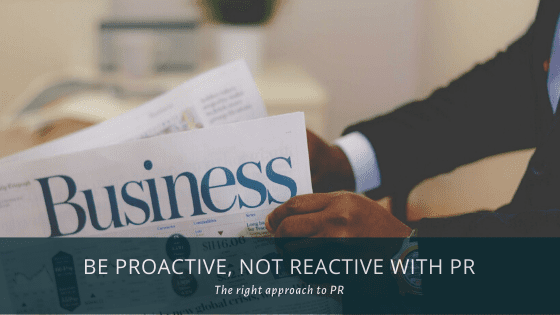The importance of PR resonates with the business community, and especially startups and SMEs that are starting out. A PR strategy is successful when it meets specific objectives– be it of lead generation, media impression or overall brand awareness.
That said, what does it take to build brand awareness? It all depends on which type of PR approach you use: proactive or reactive.
Without further ado, here are the differences between the two and why you should be proactive when it comes to PR.
Reactive PR

When companies practice reactive PR, they respond only when the need arises. In most – if not all – cases, this is a passive approach in the face of negative press.
Take for example the United Airlines controversy, where a passenger was dragged off an overbooked flight. The airline’s mistreating of the passenger and mishandling of the issue resulted in a drop in shares worth over $1.4 billion. And because social media is so powerful today, this incident sparked a global outrage when word spread.
For United Airlines, it became necessary to manage this crisis, the most obvious way of which was to turn to PR. Reactive PR can mitigate damage so as to protect a brand’s reputation when done right.
Proactive PR

On the other hand, when companies practice proactive PR, they grasp the opportunity as and when it arises. Today, the breakneck speed in which news and information travels means there is a broad range of opportunities – from announcements to trending topics.
Companies can proactively reach out to key stakeholders, such as investors and consumers, in order to form a network of relationships that will serve to increase brand awareness in the long run.
For instance, fintech companies can take advantage of the recent 2019 Singapore FinTech Festival. Either by starting a conversation or participating in an ongoing dialogue, the key is to strike while the iron is hot.
One company that does this well is UOB. Since 1982, their Painting of the Year competition has been running to support the growth and development of artistic talents in Southeast Asia. Here, UOB stands to gain positive publicity for their brand in the midst of media coverage.
On this note, here is how PR and publicity are two different things.
Why be proactive rather than reactive?

Having read so far above, you may think companies that practice reactive PR come a step too late. And, it is true.
While it is possible to be proactive even when reactive – that is, to turn crisis into opportunity – it does not reflect well for your brand to be motivated by circumstances. This is why we recommend proactive PR – so that if a crisis occurs, damage control will be easier.
Instead of having to scramble to contain the damage, a pre-established relationship of trust with your brand’s stakeholders requires reassurance on your part. In the event of bad press, then, all you’d need is to regain their confidence in your brand.
Additionally, being proactive gives you control of the type of audience that your message reaches. Such a targeted approach lets you either reach out to grow a loyal customer base or penetrate a new market to generate leads and/or media impressions.
Lastly, in the digital world where information comes and goes quickly, a proactive approach not only keeps your brand’s message from getting buried amongst other messages but also keeps it relevant in a competitive market.
We explore why PR might be the best way to capture Generation Z.
Now that you’re aware of the differences between the two, you’re only a step away from creating your very own proactive PR campaign.
If you’re curious to learn more about public relations or want to speak to a SYNC consultant about starting your brand’s PR journey, contact us at [email protected]

